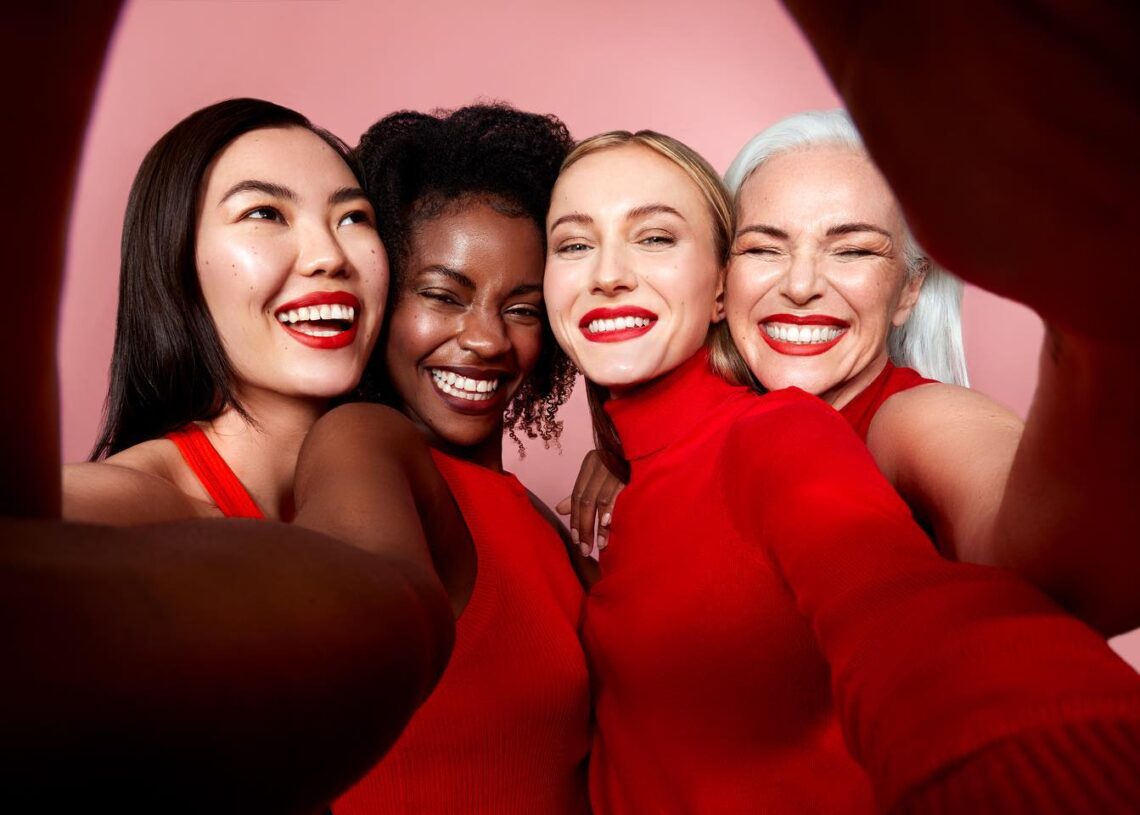Decoding Undertones: Your Foundation’s Secret Weapon
Finding the right foundation can feel like an overwhelming task. However, understanding your skin’s undertones is a game-changer. It’s the key to achieving a flawless, natural-looking complexion.
Understanding Your Skin’s Nuances
Your skin’s undertone is the subtle hue beneath the surface color, typically categorized as warm, cool, neutral, or olive. Identifying your undertone is essential for selecting makeup that complements your complexion, avoiding a mismatched or ashy look.
Several simple tests can help determine your undertone. One way is to check the color of your veins: green suggests warm undertones, while blue indicates cool undertones. Another method is to observe how gold and silver jewelry look against your skin; warmer tones often suit gold, while cooler tones favor silver. Also, consider how your skin reacts to the sun – do you tend to burn or tan?
Once you’ve identified your undertone, selecting the right foundation becomes much easier. Warm undertones usually pair well with foundations that have golden or peach bases, while cool undertones benefit from rose or blue-toned foundations. Neutral undertones can often wear a wide range of shades. Olive skin has a unique yellow-green undertone that requires special attention. Look for foundations specifically formulated for olive skin to avoid appearing ashy or dull. Many brands offer olive-toned foundations designed to enhance the natural beauty of this undertone.
When testing foundation shades, always do so in natural light along your jawline. Consider your skin type (oily, dry, or combination) and desired finish (matte, dewy, or natural). Many makeup brands label their products with W (warm), C (cool), or N (neutral) to guide your selection.
The Rise of Inclusive Beauty: Finding Your Perfect Match
The beauty industry is evolving to embrace inclusivity and cater to a diverse range of complexions, ensuring everyone finds their perfect match.
Embracing Diversity in Makeup
Inclusivity has become a cornerstone of the beauty market. Brands like Fenty Beauty, MAC, Rare Beauty, and NARS now offer extensive foundation shade ranges, often featuring 40 or more options. This shift reflects a growing consumer demand for products that cater to diverse skin tones. The launch of brands with inclusive shade ranges has had a significant impact. For instance, after one such launch, searches for “foundation for dark skin” spiked dramatically. Inclusive beauty brands experienced faster growth compared to their less inclusive counterparts, showing the commercial and ethical importance of catering to everyone.
Despite progress, challenges remain. A significant percentage of Black consumers still struggle to find suitable makeup shades and express greater dissatisfaction with available product ranges. This highlights the need for continued innovation and broader representation in product offerings. Younger consumers, particularly Gen Z, are driving further change. A large percentage of them consider diversity a key factor when purchasing cosmetics. This demand is fueling innovation in areas like adaptive color cosmetics and AI-driven personalization, aiming to better serve diverse undertones and complexions.
Mastering Color Correction: Enhancing Your Natural Beauty
Matching foundation to skin tone and undertone is a common concern, especially for those with deeper complexions. Understanding how to navigate color correction is essential for achieving a flawless look.
Color Correction Techniques for Every Tone
Undertones are the subtle hues beneath the skin’s surface and remain constant regardless of the season. Beauty experts emphasize that understanding your undertone is crucial for achieving a natural look. Expanded shade ranges in modern foundation lines now cater to both depth and undertone variations, addressing the historical lack of inclusivity.
For fair skin, the challenge is often avoiding a pink or mask-like appearance. The solution lies in choosing neutral-to-warm undertones and opting for lighter formulas. This helps the foundation blend seamlessly and enhance the skin’s natural radiance without looking heavy or artificial. Medium skin tones often face the issue of foundation turning orange or ashy. To combat this, prioritize getting the undertones right. Testing the foundation in natural daylight is essential to ensure a perfect match and avoid any unwanted color changes. Deeper skin tones can sometimes appear gray or unnatural with the wrong foundation. The key is to look for rich, pigmented formulas with red or golden undertones. These shades add warmth and dimension, preventing the foundation from creating a dull or ashy cast.
Highlighting and Shining: Achieving a Radiant Glow
Makeup techniques can enhance natural beauty, focusing on color choices and blending strategies.
Enhancing Deeper Complexions
For deeper skin tones, steer clear of lip colors with a frosty finish. Instead, opt for shades that are richer and more vibrant. These hues will flatter your complexion and bring a beautiful pop of color to your overall look, enhancing your natural radiance. When it comes to blush, explore darker shades like bricks and deep reds. These tones are particularly effective for adding warmth and definition to the cheeks. A well-chosen blush can bring life to your face and create a healthy, glowing appearance.
Don’t shy away from bold eyeshadow choices. Jewel tones and metallics, such as gold and bronze, can provide a striking contrast and luminosity. These shades can make your eyes pop and add a touch of glamour to your makeup look, perfectly complementing deeper skin. Blending is key to achieving a seamless and glowing finish. Take the time to blend your makeup thoroughly, ensuring there are no harsh lines. This will create a natural, airbrushed effect that enhances your skin’s natural beauty. The beauty industry is moving toward celebrating the unique undertones of deeper skin. Experiment with different colors and techniques to discover what best highlights your individual features. Makeup is a form of self-expression, so have fun and embrace your natural beauty.
The Perfect Nude: Finding Your Go-To Lipstick Shade
Finding the perfect nude lipstick can feel like a quest. The ideal shade should enhance your natural beauty, not wash you out.
Discovering Your Ideal Nude Lipstick
The key to a flattering nude lies in understanding your skin’s undertones. Are you warm, cool, or neutral? Warm undertones often have hints of yellow, peach, or gold. Cool undertones lean towards pink, red, or blue. Neutral undertones are a balance of both. Identifying your undertone will guide you toward the most harmonious nude shades.
If you have fair skin with warm undertones, soft terracotta or coral pink nudes can add a touch of warmth without being overwhelming. For cooler fair skin, try a pale mauve or a nude with a hint of rose. The goal is to find a shade that’s just a touch deeper than your natural lip color. Medium skin tones have more flexibility. Those with warm undertones can rock rich browns and spiced corals. If you have cooler undertones, explore berry-toned nudes or those with a hint of plum. These shades will enhance your complexion and add a touch of sophistication. Deeper skin tones look stunning in burgundy and golden-brown nudes. These shades provide a beautiful contrast and enhance the richness of your complexion. Avoid nudes that are too light, as they can appear ashy. Look for options with depth and warmth.
Beauty brands are increasingly focusing on creating universally flattering nudes. These formulas often have a balance of warm and cool tones, making them adaptable to a variety of skin tones. Matte and transfer-proof finishes are particularly popular, offering long-lasting wear and comfort. Recent beauty industry content highlights that nude lipsticks with warm undertones—such as peachy, caramel, taupe, and golden-brown shades—continue to trend for their versatility across all skin tones.
Q&A
Question 1: What is the key to finding the perfect makeup match for any skin tone?
Answer: Understanding your unique undertone (cool, warm, or neutral) is crucial. This allows you to choose foundation, blush, and lipstick shades that complement your complexion, leading to a flawless and radiant look. The article emphasizes that this is key regardless of your overall skin tone’s depth.
Question 2: How can I determine my skin’s undertone?
Answer: Several methods are suggested: check the color of your veins (green for warm, blue for cool); observe how gold and silver jewelry looks against your skin (gold for warm, silver for cool); and consider whether you burn or tan in the sun. These simple tests help identify your undertone as warm, cool, neutral, or olive.
Question 3: What are the challenges and opportunities in the inclusive beauty market?
Answer: While many brands now offer extensive shade ranges, addressing a historical lack of inclusivity, challenges remain. A significant percentage of Black consumers still struggle to find suitable shades. However, Gen Z’s focus on diversity is driving innovation in adaptive color cosmetics and AI-driven personalization, creating opportunities for even greater inclusivity.
Question 4: How can I choose the right foundation for my skin tone and undertone?
Answer: Match your undertone: warm undertones pair well with golden or peach-based foundations; cool undertones benefit from rose or blue-toned foundations; neutral undertones can wear a wider range. Always test foundation shades in natural light along your jawline, considering your skin type and desired finish. Many brands label products with W (warm), C (cool), or N (neutral). Special consideration should be given to olive undertones, requiring foundations specifically formulated for this unique yellow-green hue.
Question 5: What are some tips for achieving a radiant glow with deeper complexions?
Answer: For deeper skin tones, choose richer, more vibrant lip colors; explore darker blush shades like bricks and deep reds; experiment with bold eyeshadows like jewel tones and metallics; master the art of blending for a seamless finish; and celebrate your unique undertones by experimenting with different colors and techniques to find what best highlights your features.







